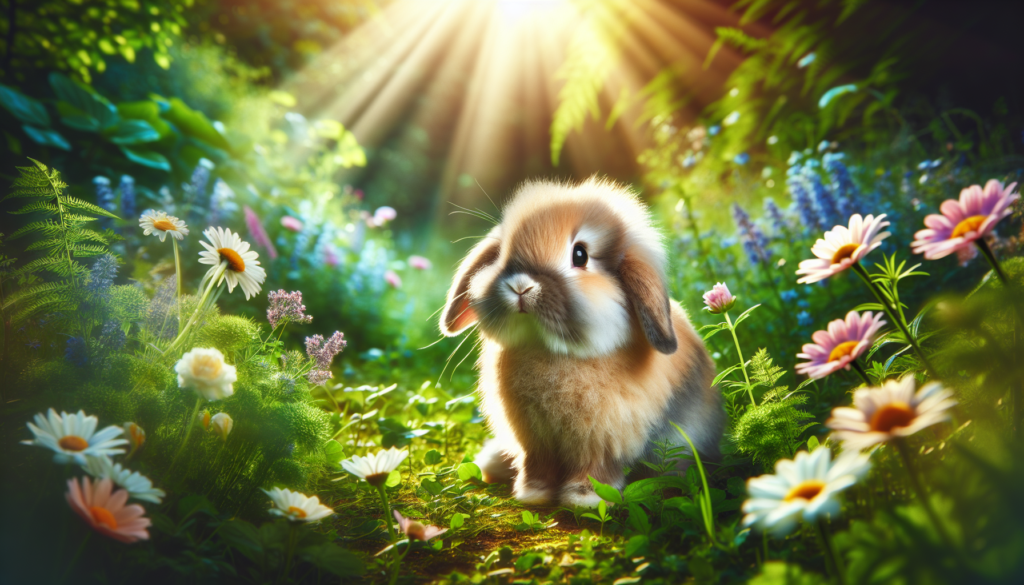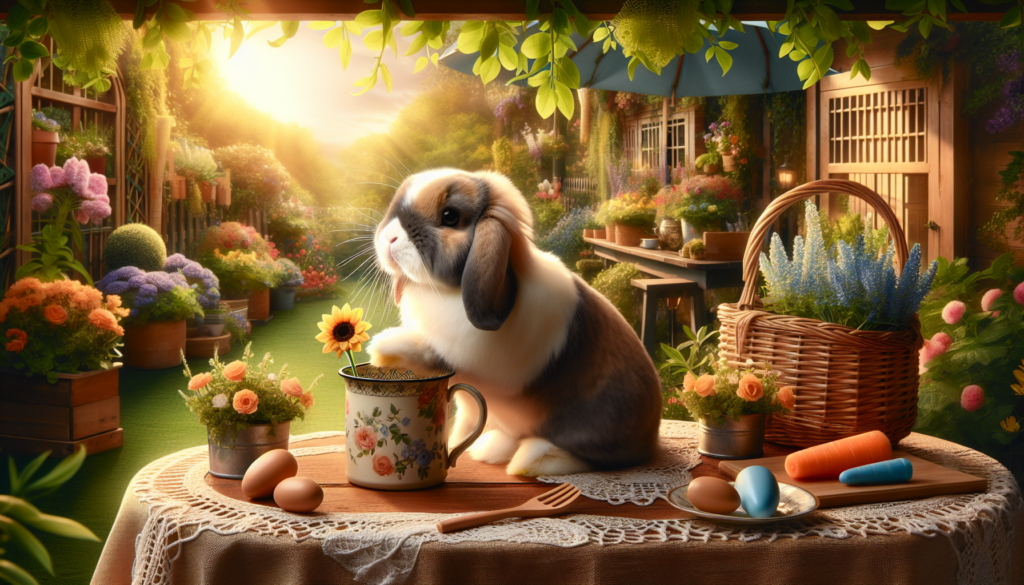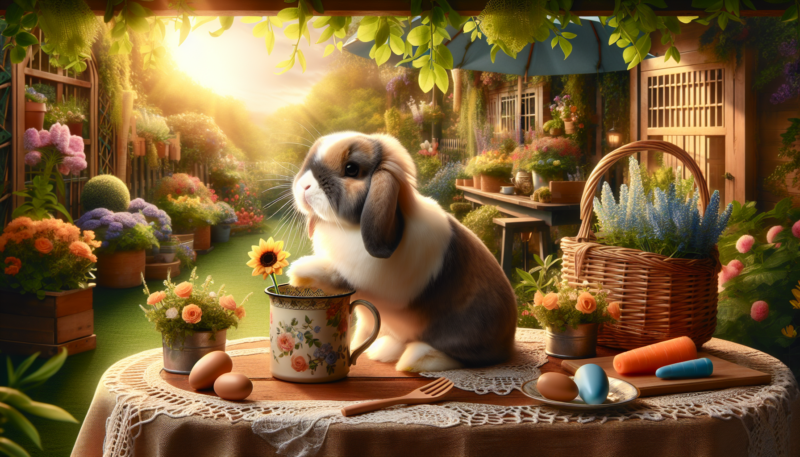Have you ever wondered if Holland Lops, those adorable and fluffy rabbits, can thrive in outdoor environments? Well, it turns out that these little creatures can indeed adapt to the great outdoors! While they are traditionally kept as indoor pets, Holland Lops have qualities that make them well-suited for outdoor living. From their strong immune systems to their natural foraging instincts, these furry friends can enjoy the freedom and fresh air that outdoor environments provide. However, there are important factors to consider when making the transition, such as providing proper shelter and protection against predators. So, if you’re thinking about giving your Holland Lop a taste of outdoor life, read on to discover how they can successfully thrive in the great outdoors!
Can Holland Lops Live Outside?
If you’re considering getting a Holland Lop rabbit as a pet, you may be wondering if they can live outside. While Holland Lops are generally indoor pets, there are several factors to consider before deciding if an outdoor environment is suitable for them. In this comprehensive article, we will explore the various factors to consider when determining if Holland Lops can live outside. We will discuss climate adaptability, housing requirements, predator protection, exercise and general health, socialization, feeding and diet, grooming needs, and the importance of supervision. By the end, you’ll have a better understanding of whether keeping a Holland Lop outside is the right choice for you and your furry friend.
Factors to Consider
When contemplating whether your Holland Lop can live outside, there are a few crucial factors to take into account. Understanding the breed characteristics, personal preference, and the available space you have will help determine if an outdoor environment is suitable for your pet rabbit. Let’s delve into these factors further.
Breed Characteristics
Holland Lops are small rabbits known for their compact size and distinctive floppy ears. They typically weigh between 2 to 4 pounds and have a friendly and docile nature, making them great companions. While they can adapt to various environments, Holland Lops are generally more suited for indoor living due to their small size and vulnerability to extreme weather conditions.
Personal Preference
Your personal preference plays a significant role in the decision to keep your Holland Lop outside. Some individuals prefer to have their pet rabbits indoors for easier supervision, while others enjoy providing a more natural outdoor environment for their furry friends. Assessing your personal preference will ensure that you choose the living arrangement that best aligns with your lifestyle and your rabbit’s well-being.
Available Space
The space you have available for your Holland Lop is another crucial factor to consider. Outdoor environments typically offer more space for rabbits to roam and explore, which can contribute to their overall happiness and well-being. However, it’s essential to evaluate the size and suitability of your outdoor space to ensure it meets the necessary requirements for your rabbit’s health and safety.

Climate Adaptability
Understanding your local climate is essential when determining if your Holland Lop can live outside. These tiny rabbits are more susceptible to extreme temperatures and are generally more comfortable in a controlled indoor environment. However, with proper precautions and adaptations, they can adapt to living outdoors. Let’s explore the various climate-related considerations in more detail.
Temperature Tolerance
Holland Lops are sensitive to temperature extremes, particularly hot weather. They are prone to heat stroke and dehydration, so it’s vital to monitor their exposure to high temperatures and provide ample shade and cool areas. In colder climates, additional measures must be taken to protect them from freezing temperatures, such as providing insulated housing and warm bedding.
Humidity Considerations
Alongside temperature, humidity also plays a role in determining if your Holland Lop can live outside. These rabbits thrive in moderate humidity levels, typically between 40% to 60%. High humidity can lead to respiratory problems, while excessively dry conditions can cause discomfort and dry out their sensitive skin. Monitoring and maintaining appropriate humidity levels in their environment is crucial for their well-being.
Seasonal Changes
Seasonal changes can bring significant challenges for rabbits living outdoors. Adapting their housing and care routine to accommodate changes in temperature, precipitation, and daylight hours becomes essential. Preparing for these seasonal changes and having appropriate measures in place ensures your Holland Lop’s comfort and health throughout the year.
Weather Protection
To provide a suitable outdoor living environment, it’s vital to consider weather protection for your Holland Lop. This includes providing proper shelter, such as a well-ventilated hutch or enclosure, to shield them from rain, wind, and extreme weather conditions. Additionally, investing in high-quality waterproof materials for bedding and nesting areas will help keep them dry and comfortable.
Housing
Creating the right housing setup is crucial when considering keeping a Holland Lop outside. Their housing needs to provide comfort, security, and protection from the elements. Here are some important factors to consider when designing their outdoor living space.
Hutch Design
Choosing the right hutch for your Holland Lop is paramount. The hutch should be sturdy, predator-proof, and provide ample ventilation. It should also have a separate sleeping area and a larger space for exercise. Opting for a hutch with a raised platform or multiple levels can give your rabbit more room to explore and provide mental stimulation.
Size Requirements
Holland Lops require adequate space to thrive. The hutch should be spacious enough for your rabbit to hop, stretch, and stand comfortably on their hind legs. As a general guideline, the hutch should be at least four times the length of your Holland Lop when fully stretched out. Having enough room in their living space promotes physical and mental well-being.
Flooring
Choosing the right flooring for the hutch is essential for your Holland Lop’s comfort and hygiene. Solid flooring made of materials like plywood or plastic is recommended as it is easier to clean and prevents potential injuries to their delicate feet. Avoid wire flooring as it can lead to painful foot sores.
Bedding and Nesting Materials
Providing suitable bedding and nesting materials is important for your Holland Lop’s overall comfort. Soft bedding made of natural materials, such as straw or hay, helps regulate their body temperature and provides a cozy resting area. Ensuring a clean and dry nesting spot is crucial for their health and well-being.

Predator Protection
Keeping your Holland Lop safe from predators is essential when considering an outdoor living environment. Rabbits are prey animals, and protecting them from potential threats is crucial for their safety and longevity. Here are some measures to consider.
Fencing and Enclosures
A secure fence or enclosure is the first line of defense against predators. Ensure the fence is high enough to prevent predators from jumping in and sturdy enough to withstand attempts to chew or dig through. Regularly inspect the enclosure for any weak spots or gaps that may compromise your Holland Lop’s safety.
Natural Deterrents
Using natural deterrents, such as aromatic plants or predator urine, can help discourage potential predators from approaching your rabbit’s living area. Planting lavender, marigolds, or other plants with strong scents around the perimeter can help keep predators at bay. However, do thorough research to ensure these plants are safe for your rabbit if ingested.
Secure Hutches
Investing in a predator-proof hutch is essential for your Holland Lop’s safety. Ensure that the hutch has sturdy locks and secure latches to prevent predators from gaining access. Regularly inspect the hutch for any signs of damage or weaknesses, and promptly repair or replace any compromised areas.
Avoiding Attractants
To further protect your Holland Lop from predators, it’s important to minimize potential attractants. Keep their living area clean and free of food scraps or other materials that may draw unwanted attention. Additionally, avoid placing the hutch in areas frequented by predators, such as near wooded areas or tall grass.
Exercise and General Health
Keeping a Holland Lop outside allows for more space to exercise and explore, which contributes to their overall health and well-being. Providing ample exercise opportunities and ensuring their general health needs are met is essential for their happiness and longevity.
Space for Exercise
Outdoor living environments often offer more space for your Holland Lop to exercise and stretch their legs. Allow them time each day to hop and explore their surroundings, promoting physical activity and mental stimulation. Incorporating secure play areas, tunnels, and toys can enhance their outdoor experience.
Social Interaction
As social animals, Holland Lops thrive on social interaction. Ensuring that your rabbit has opportunities for socialization with other household pets or other rabbits is crucial for their overall well-being. Supervised playtime and gentle introductions can help foster positive relationships and prevent loneliness or boredom.
Preventive Care
Ensuring your Holland Lop’s general health needs are met is essential for their well-being. Regular veterinary check-ups, vaccinations, and preventative treatments for parasites are necessary, regardless of whether they live indoors or outdoors. Maintaining a balanced diet, providing clean drinking water, and practicing good hygiene habits will contribute to their overall health and vitality.
Socialization
Socialization is a vital aspect of your Holland Lop’s well-being. Building positive relationships with humans, other pets, and fellow rabbits helps create a secure and stimulating environment for them.
Introducing Other Pets
When introducing your Holland Lop to other household pets, such as cats or dogs, ensure gradual introductions in a controlled environment. Allow all animals to become familiar with each other’s scents before any physical contact. Supervise interactions closely to ensure the safety of all parties involved.
Bonding with Humans
Creating a strong bond with your Holland Lop is essential for their trust and happiness. Spend quality time with your rabbit, engaging in gentle petting and interactive play. Regularly handle and cuddle your rabbit to reinforce the bond and build trust.
Interaction with Other Rabbits
If you have multiple rabbits, providing opportunities for social interaction is vital. Ensure proper introductions and gradually increase the rabbits’ time spent together under supervision. Rabbits are social animals and can benefit greatly from the companionship of their own species.
Feeding and Diet
Proper nutrition is crucial for the health and well-being of your Holland Lop. Maintaining a balanced diet that meets their dietary needs ensures they receive the necessary nutrients for optimal health.
Grass and Hay
The foundation of a Holland Lop’s diet should consist of high-quality grass and hay. Fresh Timothy, Orchard, or Meadow hay should be available at all times, promoting healthy digestion and wearing down their continuously growing teeth. Grass is also essential for their overall well-being.
Fresh Vegetables and Herbs
Supplementing their diet with fresh vegetables and herbs is important to provide additional nutrients. A variety of leafy greens, such as romaine lettuce, spinach, and kale, can be offered in small portions. Introduce new vegetables gradually to avoid digestive upsets and monitor for any adverse reactions.
Pellets
Pellets formulated specifically for rabbits should make up a portion of their diet. Look for high-quality, timothy-based pellets and feed according to your rabbit’s weight and age. Avoid overfeeding pellets, as they can lead to obesity and other health issues.
Water
Clean and fresh water should always be available for your Holland Lop. Check the water supply regularly and ensure it is free from contamination. Provide water in a suitable dispenser or bowl and refill as needed to prevent dehydration.
Grooming
Routine grooming is necessary to keep your Holland Lop clean, comfortable, and healthy. Regularly tending to their coat, nails, ears, and teeth contributes to their overall well-being.
Coat Care
Holland Lops have a dense and soft coat that requires regular care. Brushing their coat gently at least once a week removes loose fur and helps prevent matting. Longhaired Holland Lops may require more frequent brushing to prevent tangles and maintain a healthy coat.
Nail Trimming
Trimming your rabbit’s nails regularly is crucial for their comfort and mobility. Overgrown nails can result in discomfort and potential injuries. Use a guillotine-style trimmer or seek guidance from a veterinarian to ensure safe and proper nail trimming.
Ear Cleaning
Cleaning their ears on a regular basis helps prevent ear infections and maintains good ear health. Use a soft cloth or cotton ball dampened with a gentle, rabbit-safe ear cleaning solution to wipe away any dirt or debris. Avoid inserting anything into the ear canal to prevent injury.
Tooth Health
Holland Lops have continuously growing teeth, making dental care essential. Provide ample opportunities for chewing, such as safe chew toys, to help wear down their teeth naturally. Regularly monitor the condition of their teeth and consult a veterinarian if you notice any signs of dental issues.
Supervision
Regardless of whether your Holland Lop lives indoors or outdoors, supervision is crucial. Regularly observing their behavior, ensuring their living space is safe, and promptly addressing any concerns or health issues is necessary for their overall well-being.
Conclusion
Deciding whether a Holland Lop can live outside depends on various factors. Considering the breed characteristics, personal preference, and available space is crucial in making an informed decision. Climate adaptability, housing requirements, predator protection, exercise and general health, socialization, feeding and diet, grooming needs, and the importance of supervision all play a role in determining if an outdoor living environment is suitable for your Holland Lop. By taking these factors into account and providing the best care possible, you can ensure the happiness, health, and well-being of your furry friend.
